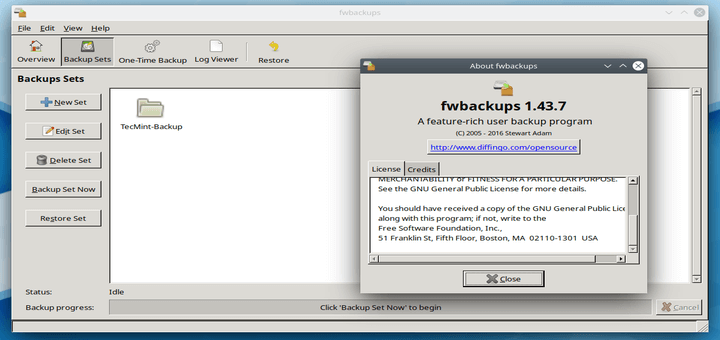

- #BACKUP GUI TAR LINUX COMMAND INSTALL#
- #BACKUP GUI TAR LINUX COMMAND UPDATE#
- #BACKUP GUI TAR LINUX COMMAND ARCHIVE#
Backup process can be stuck since Plesk update to 18.0.41 spawning a lot of backupmng processes.
#BACKUP GUI TAR LINUX COMMAND ARCHIVE#
Unable to restore Plesk backup on a different server: The archive is not valid Plesk backup or has been created in an unsupported Plesk version.Once it is set up, rsync can do all of that for you. Back up frequently, back up to many locations, and back up to different media. You can do this with the pamac package manager.īackups are absolutely vital.
#BACKUP GUI TAR LINUX COMMAND INSTALL#
In Manjaro you must install luckyBackup from the Arch User Repository (AUR). To install luckyBackup in Fedora use the following command: sudo dnf install luckybackup To install luckyBackup in Ubuntu, use the following command: sudo apt-get install luckybackup To install Grsync in Manaro use this command: sudo pacman -Syu grsync To install Grsync in Fedora, use this command: sudo dnf install grsync To install Grsync in Ubuntu, use this command: sudo apt-get install grsync You can then “roll back” to the versions of the files in any of the snapshots. For example, luckyBackup can make multiple “snapshots” of your backup. It is a backup program that uses rsync behind the scenes. The luckyBackup program is much more than a simple wrapper for rsync. It provides easy access to the rsync options and adds only a limited set of new functionality. The Grsync program concentrates on being a visual wrapper for rync. The net time rsync runs it will not have to re-transfer the portions of the partially transferred files.

The -partial option forces rsync to leave the partially transferred files on the target. rsync will delete partially transferred files caused by network glitches or other interruptions. We’re also using the -partial option here. For collections of larger files, it can reduce the transfer time in a meaningful way. The compression option will not yield significant benefits for transfers involving many small files. This compresses the file in transfer, but the file is stored uncompressed in the target directory. To speed up transfers, use the -z (compression) option. to-chk: The number of files left to be checked and verified by the optimization algorithms.xfr#: The number of files transferred so far.Time remaining: Estimated time left to transfer this file.


It will only send the differences between the files, not the entire files. When rsync is next used, it will optimize the transfers. If rsync needs to copy all of the files in their entirety (the first time it is run, for example) the speedup will be 1.0. Speedup: This is the ratio between the amount of data that had to be sent and the total amount of data that there is.This figure will represent the data that did not have to be transferred. On subsequent runs of rsync it will only transfer the file differences. Total size: Represents the size of the data that would have been sent if you were not using rsync.Bytes/sec: is the effective transfer rate.Received: The bytes received at the host.Sent: The bytes transferred to the target.rsync -rav /home/dave/Documents/ /media/dave/SILVERXHD/backups/Ī summary of the backup is presented when the copying is complete. The -v (verbose) option forces rsync to list the files as they are being copied. rsync -ra /home/dave/Documents/ /media/dave/SILVERXHD/backups/ Use the -a (archive) option to preserve file attributes such as modification dates, file ownership, access permissions, and more, for copied files, symlinks, and special block files. Preserving File Ownership and Permissions Checking on the external drive we can see the backups directory has been created, and within that directory are the contents of the “/home/dave/Documents” directory.


 0 kommentar(er)
0 kommentar(er)
